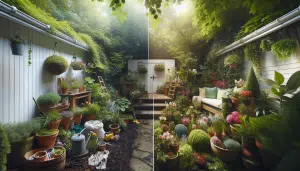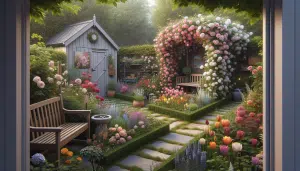Smart Ways You Can Make Small Spaces Feel Bigger
Lily Carter October 30, 2025
Maximizing every inch matters for small spaces. Discover how transformative home design choices, lighting, color schemes, and clever storage can open up compact rooms. Unlock practical, research-supported ideas to make your home feel more spacious and welcoming.
Understanding Visual Space in Compact Rooms
Small spaces often challenge comfort and style, but the principles of visual space can make dramatic differences. Visual space involves how the eye reads and interprets boundaries, light, and arrangement. Creating more openness in a room often starts with manipulating what is seen, not just what physically exists. Experts suggest that even the illusion of space can have a positive psychological impact on well-being and stress reduction, making compact living feel less restrictive and more enjoyable. Thoughtful design taps into these principles for everyday homes.
Lighting plays a crucial role in altering perceptions of size. Natural sunlight makes rooms feel airy, while shadowy corners compress them. Simple steps—like keeping window treatments minimal or adding reflective finishes—can amplify available light and visually expand any area. Strategic placement of mirrors also bounces light around, creating the impression of depth and width where there might be little physical space. Studies suggest that bright, well-lit interiors boost not only the sense of spaciousness but also mood and productivity, adding meaningful benefits for household members (Source: https://www.energy.gov/energysaver/lighting-choices-save-you-money).
Decluttering is another foundational element of maximizing small rooms. Storage solutions, vertical shelving, and multifunctional furniture keep surfaces clear. Less visible stuff means more room for air, light, and people to move, making environments feel less cramped. Homeowners frequently report that simply minimizing visible belongings changes how roomy their homes feel—even before adding new furniture or décor. The sensation of space is a blend of physical reality and mental perception, which the right design tricks can easily influence.
Strategic Use of Color and Patterns
Color psychology offers powerful guidance for opening up compact interiors. Lighter colors like soft whites, pale blues, and gentle grays reflect more light, dispersing it throughout a room and making it appear larger. Dark tones absorb light and can make walls seem to close in, so they are often reserved for accent pieces or focal points. Applying a uniform color to walls, ceilings, and trim removes harsh boundaries, blurring edges and creating seamless transitions that visually stretch the room. These subtle changes are backed by years of interior design research (Source: https://www.extension.umn.edu/consumer/personal-finance/housing/design-and-decoration/color).
The correct use of patterns further supports a spacious effect. Horizontal stripes can widen a room, while vertical lines draw the eye upward, emphasizing ceiling height. Small-scale patterns avoid overwhelming the senses, keeping the space feeling cohesive and comfortable instead of cluttered. Designers recommend using patterns sparingly on floors, rugs, or accent walls to ensure they complement the theme without dominating it. Even in homes with limited square footage, these visual cues control the perception of boundaries and distances, making rooms feel less boxed in.
Contrasting colors, when used intentionally, can also delineate zones without physical barriers. By using accent walls, two-tone cabinets, or distinctly colored furniture, it’s possible to separate functions in an open-plan area—like a studio apartment—without making the space feel fragmented. The result: zones that guide flow yet keep the main area unified and expansive. This technique boosts both aesthetic value and utility in multipurpose small spaces.
Maximizing Light and Reflection
The interplay of natural and artificial light shapes the atmosphere of any room. Large windows admit sunshine that instantly opens up confined quarters. Where windows are limited, opt for sheer or light-filtering blinds rather than blackout curtains. These alternatives preserve privacy without sacrificing brightness. Research from multiple housing authorities underscores the vital connection between daylight and perceived square footage (Source: https://www.energy.gov/eere/buildings/articles/how-do-windows-impact-energy-use-buildings).
Mirrors bring a transformative quality to small-space design. A well-placed wall mirror opposite a window doubles the impact of available sunlight, extending views outside and brightening dark alcoves. Mirrored backsplashes, glass furniture, or metallic finishes also reflect light into every corner. These reflective elements must be balanced with matte surfaces to avoid glare while maintaining a comfortable visual environment. The combination creates enchantment, making modest rooms appear more generous than their actual footprint.
Layered lighting—from ceiling fixtures to undercabinet LEDs and accent lamps—solves challenges where daylight is insufficient. Homeowners can tailor different zones for reading, relaxing, or working, adding depth and variety. Thoughtful lighting layout prevents shadows and ensures every corner gets attention, ensuring no area feels isolated or unused. Carefully coordinated lighting sets the stage for enjoying compact living without missing the freshness and clarity of larger homes.
Furniture Choices That Expand Rooms
Clever furniture choices matter in making the most of small spaces. Pieces that provide multiple functions—like sofa beds, storage ottomans, or nesting tables—let homeowners enjoy greater utility without crowding the room. Compact or modular furniture maintains flexibility, adjusting as needed when guests visit or routines change. Avoiding hefty, overstuffed sofas and sharp contrasts allows eye movement across the room, sustaining an open feeling.
Transparent furniture elements, such as glass coffee tables, acrylic chairs, or open-base shelving, minimize visual obstacles. Seeing through pieces tricks the mind into perceiving fewer barriers. This technique keeps sightlines open, essential when every square foot counts. Floating shelves or wall-mounted desks further eliminate the sense of bulk, freeing up valuable floor space for movement or rugs that visually connect different sections (Source: https://www.huduser.gov/portal/publications/strategies-for-affordable-housing.html).
Arranging furniture strategically helps small rooms breathe. Placing larger pieces against the longest wall maximizes usable area, while groupings away from pathways prevent blockages. Sitting areas positioned adjacent to windows create natural gathering points highlighted by light, reinforcing both comfort and the illusion of space. Even changing the angle of a sofa or repositioning storage units can unlock new possibilities for circulation and design impact—for little or no cost.
Innovative Storage: Out of Sight, Room in Sight
Creative storage solutions hold the key to clutter-free compact living. Under-bed drawers, wall-integrated cabinets, or storage benches multiply available room for essentials without adding visual noise. In small kitchens, drawer organizers and vertical racks keep surfaces clear, supporting efficient cooking spaces that feel open and inviting. The more belongings are put away, the more space is left for living, relaxing, and connecting.
Frequently used items gain new homes in behind-the-door hooks, pull-out pantries, or baskets tucked onto shelves. Thinking vertically—a trick borrowed from professional organizers—places seldom-used objects up high, freeing central shelves for daily needs. Open shelving can display favorite décor or plants, adding personality while keeping floors bare. When planned well, storage becomes almost invisible, silently maintaining a feeling of order and openness.
Everyday design hacks support simplicity without sacrificing function. Compact fold-down desks, stacking stools, or hidden laundry bins eliminate both visible clutter and spatial frustration. In bathrooms or entryways, wall hooks and baskets prevent piles from accumulating, ensuring no zone feels overcrowded. By integrating smart storage into original layouts, homeowners continually discover new space where none seemed to exist before (Source: https://www.cdc.gov/healthyplaces/healthtopics/healthyhomes.htm).
Customizing with Plants, Art, and Texture
Finishing touches personalize a small home without diminishing its spacious character. Houseplants, especially vertical arrangements or small succulents, draw eyes upward and bring in lively green. This natural addition merges aesthetic appeal with well-documented wellness benefits, refreshing air and providing calming views that accentuate the sensation of openness (Source: https://www.fs.usda.gov/naspf/publications/health-benefits-trees-and-urban-forests).
Artfully chosen wall art, mirrors, or textiles give personality without taking up floor area. Large, simple canvases or unframed prints in light tones extend wall space visually, while layered textiles—rugs, throws, or pillows—add coziness without clutter. Texture, when used wisely, keeps minimalist environments from feeling sterile, offering tactile comfort and visual interest. Each piece adds an element of delight without shrinking the room.
Experimenting with new arrangements is encouraged. Rotating art, changing pillow covers, or updating shelving displays brings seasonal refreshes that maintain an evolving sense of space. Flexibility allows homeowners to enjoy both the charm of a curated interior and the freshness of an uncluttered one. Balance is the goal, merging creative expression with the enduring illusion of spaciousness—a recipe anyone can apply for happier living, no matter the size of their home.
References
1. U.S. Department of Energy. (n.d.). Lighting Choices Save You Money. Retrieved from https://www.energy.gov/energysaver/lighting-choices-save-you-money
2. University of Minnesota Extension. (n.d.). Color in Design and Decoration. Retrieved from https://www.extension.umn.edu/consumer/personal-finance/housing/design-and-decoration/color
3. U.S. Department of Energy, Office of Energy Efficiency & Renewable Energy. (n.d.). How Do Windows Impact Energy Use in Buildings? Retrieved from https://www.energy.gov/eere/buildings/articles/how-do-windows-impact-energy-use-buildings
4. U.S. Department of Housing and Urban Development. (n.d.). Strategies for Affordable Housing. Retrieved from https://www.huduser.gov/portal/publications/strategies-for-affordable-housing.html
5. Centers for Disease Control and Prevention. (n.d.). Healthy Homes. Retrieved from https://www.cdc.gov/healthyplaces/healthtopics/healthyhomes.htm
6. USDA Forest Service. (n.d.). Health Benefits of Trees and Urban Forests. Retrieved from https://www.fs.usda.gov/naspf/publications/health-benefits-trees-and-urban-forests







